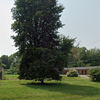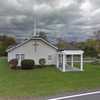Karner blue count dips below sustainable
GUILDERLAND The count for Karner blue butterflies in the Albany Pine Bush is now below 3,000, the number the Federal Recovery Plan of 2005 says is the cut-off for a sustainable population.
Decades of development encroaching on the rare inland pine barrens the Karner blue’s habitat reduced the numbers from millions in the 1940s, to 65,000 in 1980, and to barely 1,000 early in this decade.
“We’re still doing all we can for this species, and we’re hoping we can get to the point where numbers are increasing,” said Kathy O’Brien, with the endangered species unit of the state’s Department of Environmental Conservation. The Karner blue butterfly is on the federal endangered species list.
“A number of 3,000 signifies a meta-population, meaning the species are inter-breeding and interacting,” O’Brien said, adding that ideally there would be a cushion of more than 3,000, and the DEC is discussing how to make that happen.
Science teacher Grace Nichols, active in the watchdog group Save the Pine Bush, is raising concerns over the reasons for the dip in population, asserting in a letter to the Enterprise editor that the DEC is keeping insect reports “top secret.” Nichols said she filed a Freedom of Information Law request for the reports, and was denied.
O’Brien told The Enterprise that the population reports are not being kept secret, but said the DEC does not give out site specific information on endangered species, for a variety of reasons.
Some people view endangered species as collectibles, O’Brien said, and the DEC does not provide information on where exactly the organisms in danger of extinction live, to dissuade collectors from finding them.
Some of the Karner blues live on privately owned property, which also prevents information from becoming public, according to O’Brien. Also, she said, only index counts are available, meaning any population number provided would be an estimate.
“We have index counts, and we would be able to say the numbers are higher, lower, or about the same as previous years.” O’Brien said, noting that it is true that numbers are low this year.
In her letter, Nichols questions why the numbers of the endangered butterfly were down in the Albany area. “I don’t think we know, but we need to find out,” Nichols said.
According to O’Brien, the reasons for the population decline are no secret.
“They have very small pockets of existence, making them vulnerable,” said O’Brien. In the Pine Bush, their sites are scattered, making it hard for them to find each other. The weather, with an early spring warm-up and subsequent cool-down, and several hail storms, has not helped, she said, stating that Karner blues like warm, sunny conditions.
Nichols, in her letter, wonders why the population is faring better in Wilton than it is in Albany, something she says she heard at the Wilton Wildlife Park and Preserve. O’Brien said it’s due to a combination of habitat work and pure luck. It was lucky that one female laid many eggs, she said, but it doesn’t mean the species isn’t still vulnerable. It remains to be seen how those eggs will fare.
Similar habitat work is being done in the Pine Bush, said O’Brien. Clones of locust are being removed, and native grasses and lupines are being re-planted, she said. The caterpillars of the Karner blue butterflies feed on the native lupine.
Nichols raises concerns in her letter about pesticides used by the Rapp Road landfill, after she recently worked to raise awareness about the dangerous rodenticide Brodifacoum; her work helped lead to a decision to ban the use of Brodifacoum in the area, after animal autopsies showed traces of the poison in the bloodstreams of several mammals and birds.
O’Brien said the Rapp Road landfill expansion habitat restoration plan, drawn up as part of the blueprint for the landfill’s fifth expansion, should be beneficial to the Karner blue and other endangered species. Contrary to the belief that herbicides spread at the landfill are harmful to the butterflies, O’Brien said the specific use of herbicides can be a tool in habitat management.
“I really don’t see anything happening at the landfill as affecting the butterfly population,” she said.


